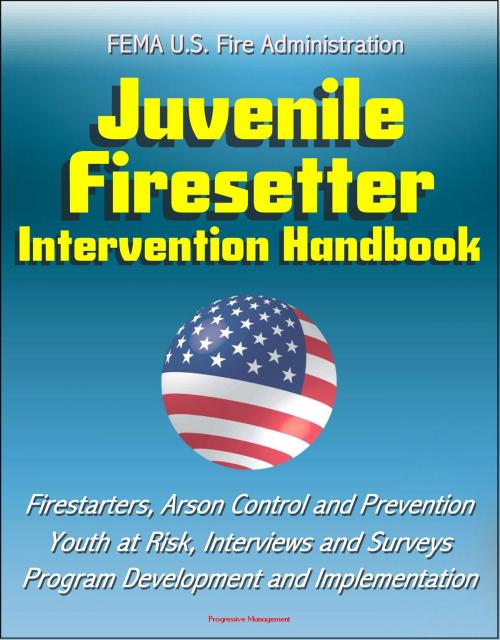FEMA U.S. Fire Administration Juvenile Firesetter Intervention Handbook: Firestarters, Arson Control and Prevention, Youth at Risk, Interviews and Surveys, Program Development and Implementation
Nonfiction, Social & Cultural Studies, Social Science| Author: | Progressive Management | ISBN: | 9781476070247 |
| Publisher: | Progressive Management | Publication: | August 21, 2012 |
| Imprint: | Smashwords Edition | Language: | English |
| Author: | Progressive Management |
| ISBN: | 9781476070247 |
| Publisher: | Progressive Management |
| Publication: | August 21, 2012 |
| Imprint: | Smashwords Edition |
| Language: | English |
This Juvenile Firesetter Intervention Handbook is designed to teach communities how to develop an effective juvenile firesetter intervention program. The six chapters of this Handbook can be viewed as the six building blocks essential to construct a successful program. The cornerstone of the blueprint is understanding the personality profiles of juvenile firesetters and their families. The next step is identifying at-risk youth and assessing the likelihood that they will become involved in future firesetting incidents. The identification of the three levels of firesetting risk--little, definite, and extreme--leads to specific types of intervention, including evaluation, education, referral and follow-up. These are the critical components of a juvenile firesetter program. To provide a complete complement of services to juvenile firesetters and their families, the juvenile firesetter program must be part of a community network.
Target audiences for this Handbook are diverse. Because the fire service operates the majority of juvenile firesetter programs, these chapters are designed specifically to meet its needs. Fire educators, fire prevention specialists, arson investigators, juvenile firesetter program managers, interviewers, educators, and team members all will find this information useful. In addition, because juvenile firesetter programs are part of a community network, many other professionals working in the human service arena will benefit from the Handbook. These professionals include law enforcement, mental health, school personnel, child protective services, social services, and juvenile justice. A planned and coordinated effort on the part of the fire service and human service organizations is the best way to reduce juvenile involvement in firesetting and arson and to protect and preserve lives and property in our communities.
CHAPTER 1 * JUVENILE FIRESETTERS AND THEIR FAMILIES * A. FIRE BEHAVIOR * 1. Fire Interest * 2. Firestarting * 3. Firesetting * 4. Arson * B. YOUTH AT-RISK. * 1. Little Risk * 2. Definite Risk * A. Troubled Juveniles * B. Delinquent Juveniles * 3. Extreme Risk * C. SUMMARY POINTS * D. SUGGESTED READINGS * CHAPTER 2 * IDENTIFICATION TO ASSIGNMENT * A. IDENTIFICATION * B. ASSESSMENT * 1. Legal Action * 2. Voluntary Action * C. ASSIGNMENT * 1. Screening * 2. Intake * D. SUMMARY POINTS * E. SUGGESTED READING * CHAPTER 3 * EVALUATION * A. RISK DETERMINATION * 1. Comparing Interview Instruments * B. THE INTERVIEW * 1. The Target Populations * 2. The Interview Format * A. Location * B. Setting * C. Scheduled Time * D. Sequence * E. Recording the Interview * 3. Interview Style * A. The Interviewer * I. Expectations * II. Rapport * III. Asking the Questions * IV. Attentive Listening * 4. Special Situations * A. Young Children * B. Language * C. Resistance * D. Abuse * E. Severe Mental Disorder * F. Criminal Behavior * G. Confidentiality * H. Supplementary Interviews * I. Legal Issues * C. THE JUVENILE FIRESETTER CHILD AND FAMILY RISK SURVEYS * D. THE COMPREHENSIVE FIRE RISK EVALUATION * E. SUMMARY POINTS * G. SUGGESTED READINGS * CHAPTER 4 * INTERVENTION * A. CONTINUUM OF CARE * 1. Points of Intervention * B. THE JUVENILE FIRESETTER PROGRAM * 1. Identification to Assignment * A. Early Identification * B. Assessment * C. Assignment * 2. Evaluation * 3. Education * A. Goals * B. Target Group * C. Format * D. Materials * 4. Referral * 5. Exit to Follow-up * C. ADDITIONAL COMPONENTS * 1. Community Service * 2. Restitution * 3. Counseling * D. JUVENILE FIRESETTER PROGRAMS - A SELECTED SAMPLE
This Juvenile Firesetter Intervention Handbook is designed to teach communities how to develop an effective juvenile firesetter intervention program. The six chapters of this Handbook can be viewed as the six building blocks essential to construct a successful program. The cornerstone of the blueprint is understanding the personality profiles of juvenile firesetters and their families. The next step is identifying at-risk youth and assessing the likelihood that they will become involved in future firesetting incidents. The identification of the three levels of firesetting risk--little, definite, and extreme--leads to specific types of intervention, including evaluation, education, referral and follow-up. These are the critical components of a juvenile firesetter program. To provide a complete complement of services to juvenile firesetters and their families, the juvenile firesetter program must be part of a community network.
Target audiences for this Handbook are diverse. Because the fire service operates the majority of juvenile firesetter programs, these chapters are designed specifically to meet its needs. Fire educators, fire prevention specialists, arson investigators, juvenile firesetter program managers, interviewers, educators, and team members all will find this information useful. In addition, because juvenile firesetter programs are part of a community network, many other professionals working in the human service arena will benefit from the Handbook. These professionals include law enforcement, mental health, school personnel, child protective services, social services, and juvenile justice. A planned and coordinated effort on the part of the fire service and human service organizations is the best way to reduce juvenile involvement in firesetting and arson and to protect and preserve lives and property in our communities.
CHAPTER 1 * JUVENILE FIRESETTERS AND THEIR FAMILIES * A. FIRE BEHAVIOR * 1. Fire Interest * 2. Firestarting * 3. Firesetting * 4. Arson * B. YOUTH AT-RISK. * 1. Little Risk * 2. Definite Risk * A. Troubled Juveniles * B. Delinquent Juveniles * 3. Extreme Risk * C. SUMMARY POINTS * D. SUGGESTED READINGS * CHAPTER 2 * IDENTIFICATION TO ASSIGNMENT * A. IDENTIFICATION * B. ASSESSMENT * 1. Legal Action * 2. Voluntary Action * C. ASSIGNMENT * 1. Screening * 2. Intake * D. SUMMARY POINTS * E. SUGGESTED READING * CHAPTER 3 * EVALUATION * A. RISK DETERMINATION * 1. Comparing Interview Instruments * B. THE INTERVIEW * 1. The Target Populations * 2. The Interview Format * A. Location * B. Setting * C. Scheduled Time * D. Sequence * E. Recording the Interview * 3. Interview Style * A. The Interviewer * I. Expectations * II. Rapport * III. Asking the Questions * IV. Attentive Listening * 4. Special Situations * A. Young Children * B. Language * C. Resistance * D. Abuse * E. Severe Mental Disorder * F. Criminal Behavior * G. Confidentiality * H. Supplementary Interviews * I. Legal Issues * C. THE JUVENILE FIRESETTER CHILD AND FAMILY RISK SURVEYS * D. THE COMPREHENSIVE FIRE RISK EVALUATION * E. SUMMARY POINTS * G. SUGGESTED READINGS * CHAPTER 4 * INTERVENTION * A. CONTINUUM OF CARE * 1. Points of Intervention * B. THE JUVENILE FIRESETTER PROGRAM * 1. Identification to Assignment * A. Early Identification * B. Assessment * C. Assignment * 2. Evaluation * 3. Education * A. Goals * B. Target Group * C. Format * D. Materials * 4. Referral * 5. Exit to Follow-up * C. ADDITIONAL COMPONENTS * 1. Community Service * 2. Restitution * 3. Counseling * D. JUVENILE FIRESETTER PROGRAMS - A SELECTED SAMPLE















